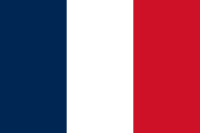Flag of the Central African Republic

 Flag ratio: 3:5
Flag ratio: 3:5The flag of the Central African Republic was adopted on December 1, 1958. It was designed by Barthélemy Boganda, the first president of the autonomous territory of Oubangui-Chari, who believed that "France and Africa must march together." Thus he combined the blue, white and red of the French tricolour and the Pan-African colors red, green and yellow.
According to its official description, red symbolizes the blood of the people of the nation, the blood that was spilt in order to bring it independence, and the blood that they would spill to protect their nation. Blue represents the sky and freedom. White represents peace, and dignity. Green represents hope, and faith. Yellow represents tolerance.
From 1976 to 1979, during the existence of the Central African Empire, an imperial standard was designed for Emperor Bokassa I's personal use. The standard was light green in color, with a gold-colored eagle in the centre superimposed over a 20-pointed gold star, inspired by the eagle on the imperial standard of Napoleon I. The nation's national flag, however, remained unchanged.[1]
Former flags
 |

|
| Flag of Ubangi-Shari as a territory of France (1903–1960) | Imperial Standard of Bokassa I (1976-1979) |
|---|
References
External links
